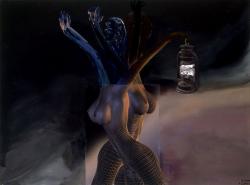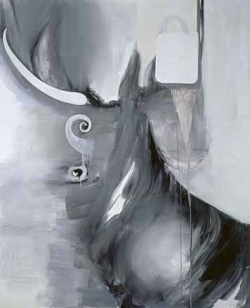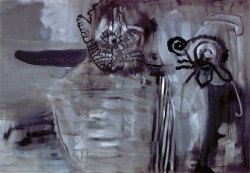
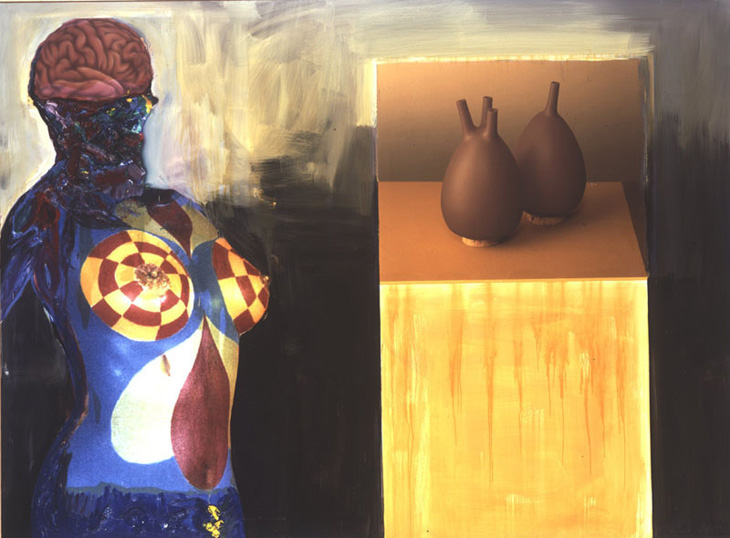
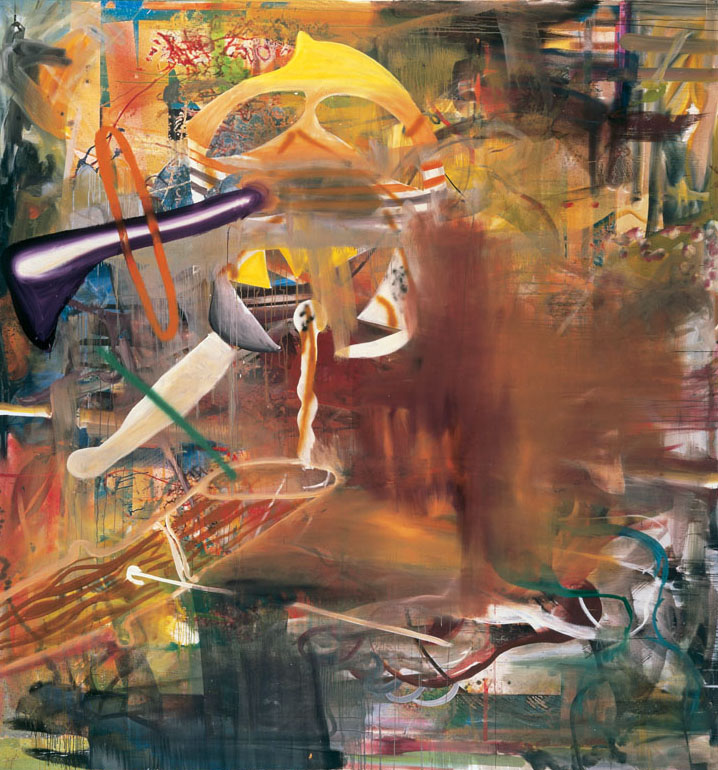

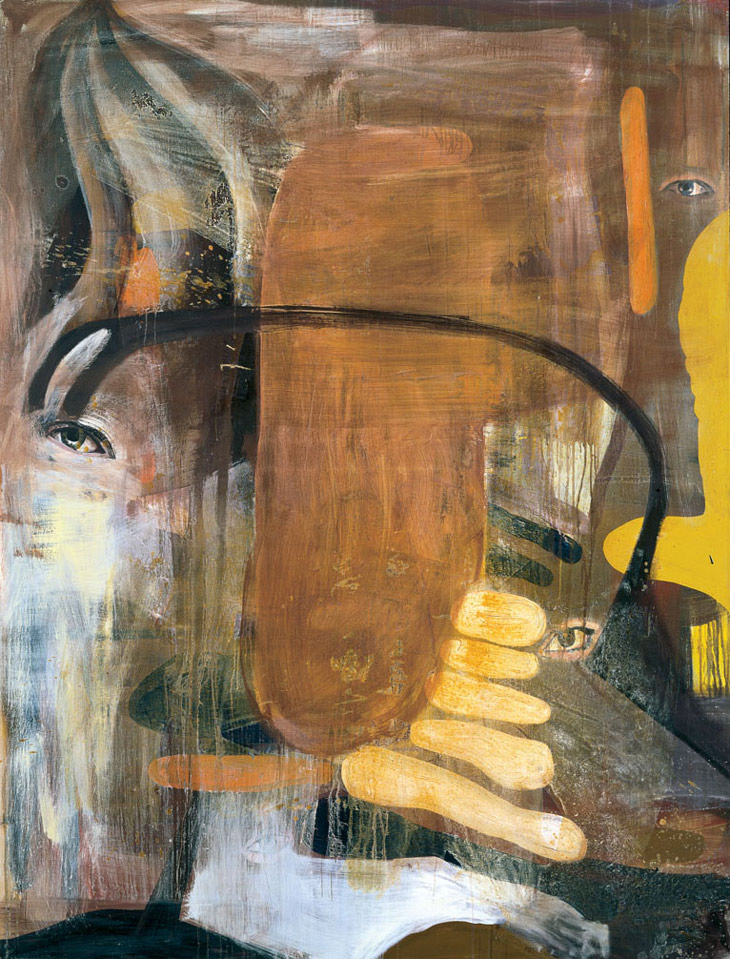
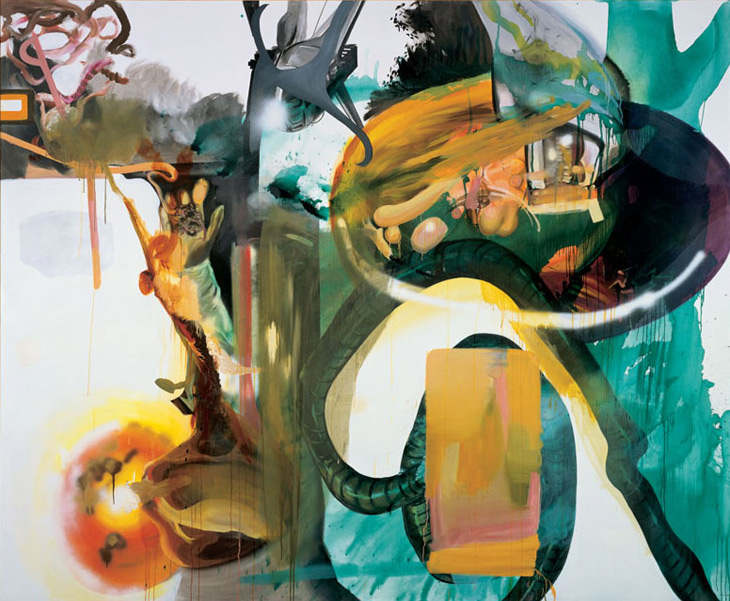
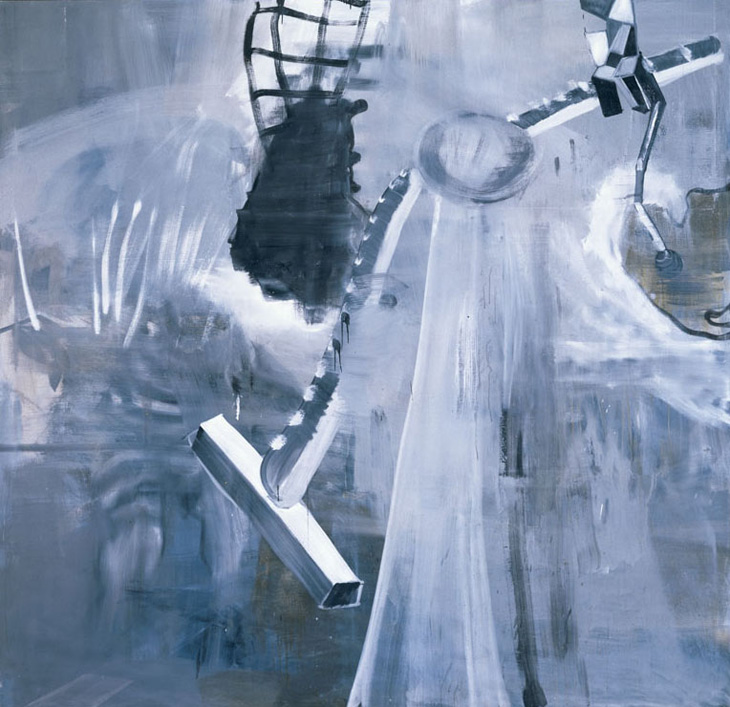

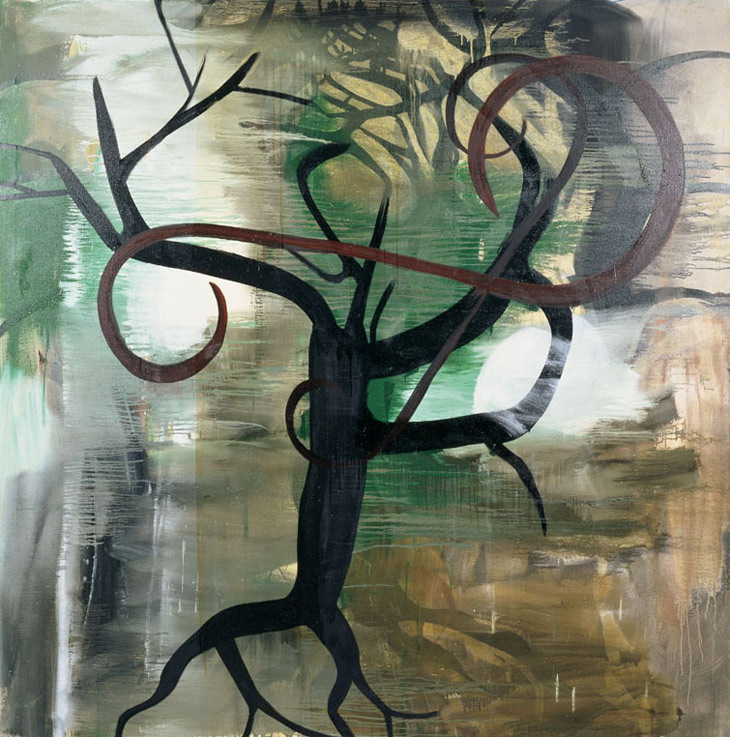
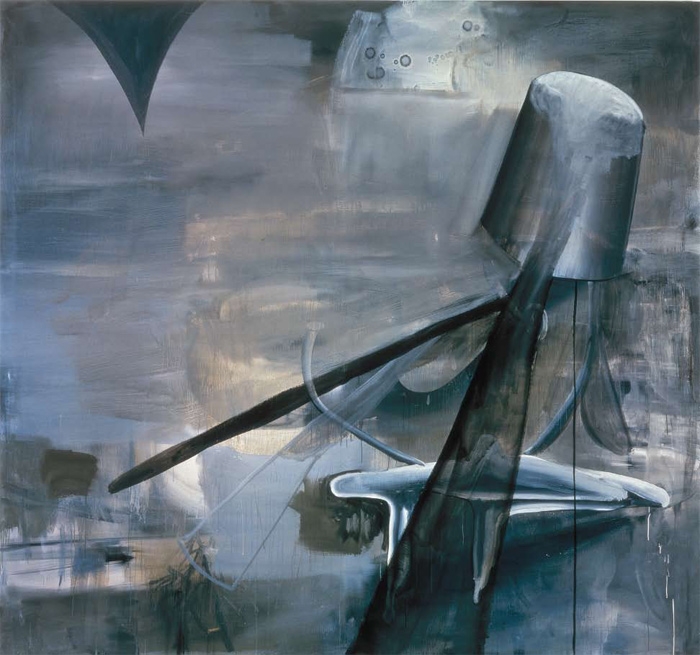
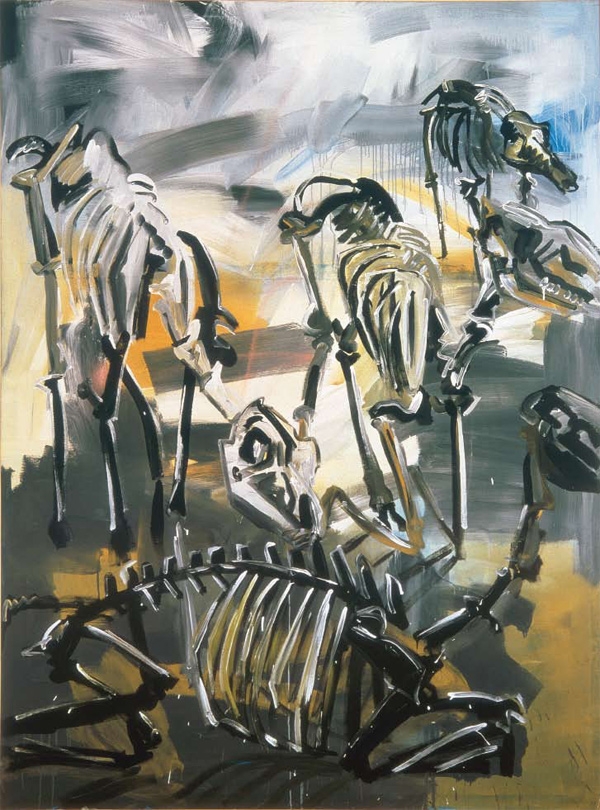

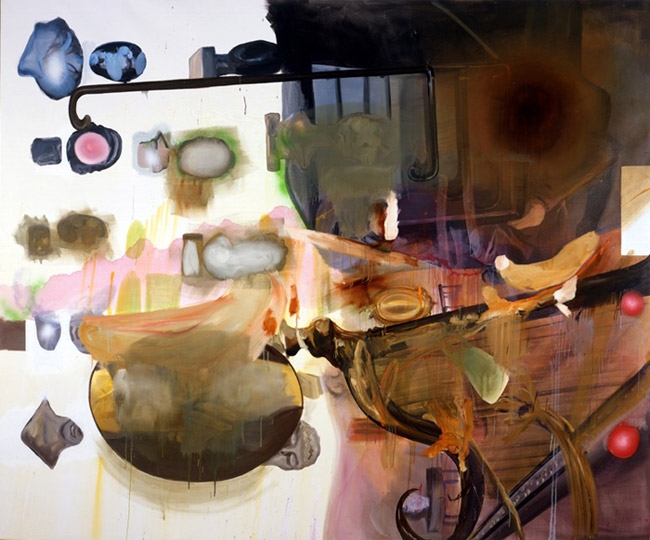

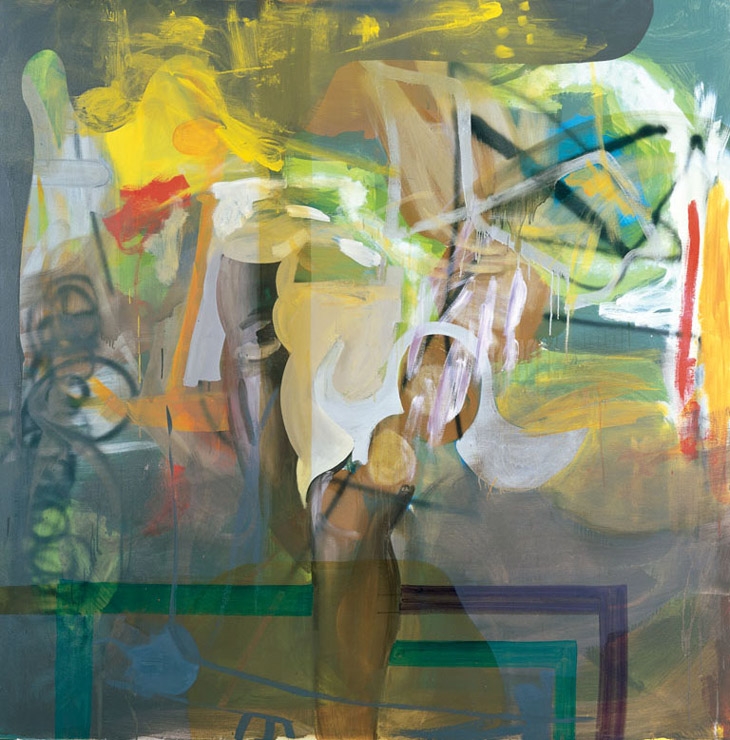
Albert Oehlen
Oehlen approaches painting with the uncontrollability of Tourette's syndrome. Chaotic and visually overloaded, Peon exudes an earnest conviction undermined by its own frantic expression. Elements of composition and style undulate with individual promise. Together, they are mutually rejective compounds violently clamouring for attention. Oehlen presents an image of breakdown: painting in its most agitated state, clawing for meaning and reason.
Albert Oehlen is a master of ironic wit and his paintings are elaborate strategies of provocation. In Untitled, Albert Oehlen subverts the authority of the avant-garde, creating an abstraction of dumbed-down abjection. His painting poses as a deceptive icon of aesthetic contemplation, punctuated with flirtatious eyes returning the viewer’s gaze. In Piece, Albert Oehlen combines aspects of figurative sexuality, mechanical distance and painterly abstraction. It’s a bastard hybrid of painting, incorporating smooth polished forms, heavy brushwork, and the implied photo-gloss of airbrush. The end result is more like a collage than a painting: a loud and exasperating argument in different tongues, promising never to be resolved for lack of a common idiom. Albert Oehlen denies Interior both colour and pictorial subject. Instead, he offers the canvas as a rudimentary plan, a crude impression of possibility. By denying customary modes of critique, Albert Oehlen questions how the function and value of painting might be developed outside a historical hierarchy of aesthetics and form. In a collaborative process made simple, Albert Oehlen provides the photographic material and both artists take turns painting around it. None of these works are immediately recognisable as Albert Oehlen or Meese, and that’s what makes them so good. Like a nuclear fusion, the two become one; an invincible super-artist refining the best qualities of both.The Greeting is a ridiculous portrait of a lumpy gangly-armed housewife waving about a feather duster/penis, teetering on glamour model’s legs. They render her almost obscenely repulsive, but the sexual delusion of the male gaze is inevitable: the artists’ collage in a mirror to peek up her dress. Albert Oehlen describes his paintings as ‘post-non-representational’. Through exploring and challenging the tropes and expectations of conventional abstraction, he strives to reconstitute a contemporary meaning for art as an independently articulate form.
In works such as Untitled, Albert Oehlen lavishes the picture plane with a clichéd exaggeration of painterly expression. Awkwardly encumbered, the sophistication of Untitled lies in its audacity, teetering on the razor edge between misfortune and masterpiece. Albert Oehlen’s paintings are neither beautiful nor seductive. Their self-consciously brutal surfaces seem to be corrupted from within, a perversion of the paintings they might have been.
In Descending Hot Rays, Albert Oehlen’s monotone canvas occupies a space between representation and abstraction, his forms and textures converging not to create an illusion, but a suggestion of invention.
Traditional painterly expression is infused with a steely reference to technology. His work offers a raw confrontation with the deficiencies of visual language. Albert Oehlen doesn’t use paint to convey meaning, but rather to explore the possibilities of the medium’s ‘function’. Black Rationality appropriates the tones and equestrian subject of historical painting and re-renders them as a punk-ethic effigy. The skeletons of the horses provide a Picasso-like motif. Seemingly two paintings in one, Black Rationality is a painting in conflict. Albert Oehlen sets up the flatness of an abstract expressionist ground; the figures are placed as a separate layer creating an illusion of perspective.
In an optical contention between surface and depth, Albert Oehlen exposes the limitations of both abstraction and representation to denounce and eulogise artistic tradition. In a literal depiction of a graveyard, Albert Oehlen presents painting as a hallowed myth, resonant beyond its expiration. Albert Oehlen’s paintings humorously critique the hallowed respect and predominant values of traditional painting. In Fibreglass Scroll, his sensitively treated surface adopts the ephemeral radiance of Abstract Expressionism, alluding to an aura of mysticism and spirituality.
Devoid of colour, Albert Oehlen’s passionate brushwork becomes a hollow gesture; his black and white palette relegates the sincerity of painting to the annals of history. Stylised flat shapes float above Albert Oehlen’s painterly field, transforming his abstract composition to a Picasso-like animal, uncontrollably wild and dumb. Albert Oehlen relishes the sensitivity of his medium in this celebration of painterly illusion: puddles and washes convey a refracted, dreamlike sensibility, while almost recognisable objects emerge and dissolve against the fluid ground. An explicit confession of deception, Albert Oehlen creates a convincing sense of space: a purely abstract fabrication boldly exposing its own construction. Titanium Cat… reads like a page torn from a 1950’s exhibition catalogue: an exaggeratedly expressionistic painting entirely stripped of colour. Rendered defunct from the start, Albert Oehlen revels in its self-styled retardation. A decoded script of interrupted image and muted texture, takes its pleasure in contrast and surface. Oehlen describes his paintings as "post-non-representational". Through exploring and challenging the tropes and expectations of conventional abstraction, he strives to reconstitute a contemporary meaning for art as an independently articulate form. In works such as Untitled, Oehlen lavishes the picture plane with a clich’d exaggeration of painterly expression. Awkwardly encumbered, the sophistication of Untitled lies in its audacity, teetering on the razor edge between misfortune and masterpiece.
